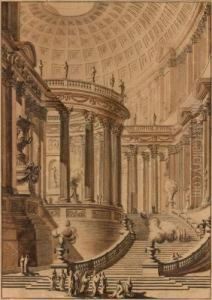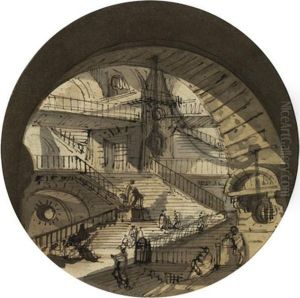Louis Francois Petit-Radel Paintings
Louis François Petit-Radel was a French architect and engraver, born in 1739 and passing away in 1818. He was a figure of the Enlightenment, living through a period of tremendous change in France, including the French Revolution and the early years of the Napoleonic era. Petit-Radel's work and career reflect the transitional period in French architecture from the late Baroque and Rococo styles to the emergence of Neoclassicism, which sought to revive the principles and aesthetics of ancient Roman and Greek architecture.
Petit-Radel studied under Jacques-François Blondel, a prominent French architect who played a crucial role in the development of Neoclassicism in France. Under Blondel's guidance, Petit-Radel honed his skills not only in architecture but also in engraving, which allowed him to publish several works on architectural theory and history. His publications contributed significantly to the architectural discourse of his time, focusing on the restoration and preservation of ancient monuments, a topic that gained increasing importance during his lifetime.
Although not as widely recognized as some of his contemporaries, such as Claude Nicolas Ledoux or Jean-François-Thérèse Chalgrin, Petit-Radel's architectural works, including private residences and public buildings, showcased the evolving tastes of the era. He was particularly interested in the application of archaeological discoveries to contemporary architectural practice, advocating for a rigorous study of classical models.
In addition to his practical and theoretical contributions to architecture, Petit-Radel played a role in the education of future architects. He was involved with the Académie Royale d'Architecture, the prestigious institution responsible for the training of architects in France. His engagement in architectural education and his efforts to preserve historical monuments underscore his commitment to the cultural and architectural heritage of France.
Petit-Radel's legacy lies in his contribution to the architectural literature of his time and his efforts to blend the lessons of the past with the needs of the present. His work on the preservation of ancient monuments anticipated some of the concerns of modern heritage conservation. Despite the relative obscurity of his built works, his writings continue to offer insights into the architectural thought of the late 18th and early 19th centuries, a period of significant transition in European architectural history.

